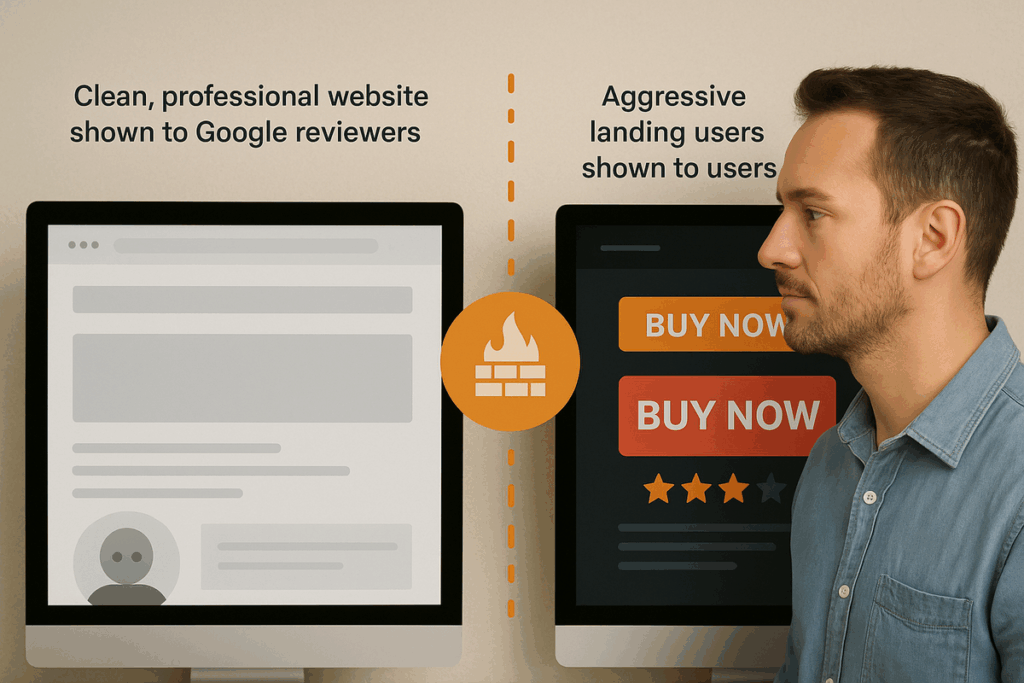You Can Still Cloak — If You’re Smart About It

If you’ve ever run an affiliate campaign in a “spicy” niche, you know cloaking isn’t optional — it’s survival. Nutra, crypto, sweepstakes, adult, gambling… platforms don’t love these verticals, but they convert like wildfire. That’s why so many media buyers rely on cloaking to keep campaigns alive. The challenge? The Google cloaking ban is smarter, faster, and more aggressive than ever.
One slip, and you’re not just dealing with disapproved ads — you’re risking full account shutdowns, domain blacklisting, and serious loss of ad spend.
Let’s break down why the Google cloaking ban hits so hard — and how you can still run cloaked campaigns safely with the right smart filtering setup.
What Is Cloaking, Really?
At its core, cloaking is the art of showing one version of your site to the ad reviewer, and a different one to real users. It’s digital sleight of hand and in performance marketing, it’s often the only way to get a “grey hat” offer approved.
Think of it like this:
- The reviewer sees a clean, boring blog page about healthy recipes.
- The user lands on a weight loss offer with a countdown timer and testimonials from “Dr. Oz.”
That’s cloaking. And it’s everywhere — in lead gen, native arbitrage, even eComm if you’re selling borderline products.
How Google Actually Catches Cloaking
Ten years ago, all you had to do was detect Googlebot or block reviewer IPs. Those days are gone.
Now, Google uses a mix of:
1. Reviewer IP & Proxy Networks
They come from residential proxies, mobile IPs, and geos you wouldn’t expect.
2. Device & Browser Spoofing
Bots no longer look like bots. They behave like real users, scrolling, clicking, interacting.
3. Behavioral Tracking
Bounce rate too high? Page loads something shady for users but not reviewers? That raises flags.
4. Reporting Patterns
If users hit “Why did I see this ad?” or file complaints, your funnel gets re-reviewed — this time with serious scrutiny.
The short version: if your cloaker isn’t bulletproof, you’ll eventually get caught.
The Smarter Way: Cloak With Filters, Not Tricks
There’s a big difference between using a basic script to “hide” your content and actually controlling who sees what.
That’s where smart filtering comes in.
Tools like TrafficShield don’t just cloak — they analyze traffic in real time and filter bots, reviewers, suspicious ISPs, and anything else that smells off.
This isn’t about hiding, it’s about controlling visibility like a sniper, not a shotgun.
What a Real Smart Filtering Setup Looks Like
If you’re serious about running cloaked campaigns in 2025, your setup should include:
- Server-side cloaking
- Dynamic IP + ASN filtering
- Mobile carrier detection
- Browser fingerprinting
- Click log analytics
TrafficShield let you fine-tune this like a control panel:
That’s what keeps campaigns alive.
Want to Avoid a Ban? Do These 6 Things:
Here’s a quick survival list. Follow it, and you’ll drastically cut your risk of getting nailed by the Google cloaking ban:
- Use throwaway domains — Never run traffic to your brand site. Ever.
- Keep your bridge page believable — Reviewers are trained to sniff out garbage.
- Scrub your traffic — Not just Googlebot. Kill the weird ISPs, suspicious devices, and bot behavior.
- Watch your bounce rate — Reviewers will re-check if engagement drops.
- Don’t get greedy — Scaling too fast raises flags, especially if the offer’s aggressive.
- Track everything — If you don’t know what traffic saw what, you’re flying blind.
One more tip? Don’t test on live spend. Use a small whitelist campaign to test setups before going wide.
Real Talk: Case Study from the Field
A media buyer I know “Jay” — runs nutra on Google Display. Pre-TrafficShield, his ads barely lasted 48 hours. He’d get approved, push traffic, and boom — account disabled.
After setting up filtering with geo/IP rules, and cloaking reviewers with a clean blog template, here’s what changed:
- Campaigns ran for 10+ days straight
- Approval rate on new creatives jumped by 50%
- ROAS went from 1.4 to 3.1
- He scaled to $3K/day on just two offers
Jay didn’t change his product. He just stopped getting caught.
Google Ads Misrepresentation Policy
Final Takeaway
Cloaking isn’t dead. It’s just evolved.
The days of lazy redirects and copy-paste scripts are over. If you’re serious about running high-risk offers in today’s environment, you need tools like Trafficshield i.e built for today’s platforms — not yesterday’s hacks.
The Google cloaking ban will only get tougher. But with smart filtering tool, sharp execution, and the right tech, you can stay under the radar and keep scaling.
Need to stay live longer and run hotter offers? Then you need cloaker plus strategy.
Also Read :
- Cloaking in Digital Marketing: 14 Days of Real Campaign Results with TrafficShield
- From Banned to Booming: Native Ads Arbitrage Cloaking Success with TrafficShield
FAQs
1. Is cloaking illegal or just against ad policies?
While cloaking goes against ad platform policies, it’s not illegal — and with the right strategy, you can keep campaigns running smoothly and protect your revenue.
2. Can smart filtering really prevent bans?
It lowers your risk dramatically, especially when paired with clean pre-landers and tight targeting.
3. What’s the best cloaking tool right now?
TrafficShield is one of the top contenders, AI filters, and real-time tracking built for affiliate marketers.
4. Should I still cloak in 2025?
If you’re running aggressive or high-risk offers, it’s almost a must — but do it smart, or not at all.
5. How fast can Google catch me if my cloaking setup sucks?
Sometimes in minutes. Especially if you don’t filter bots or serve the same offer to reviewers.




